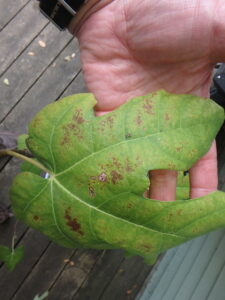Have Happy Houseplants in Summer
Posted on Tuesday, August 2, 2022 · Leave a Comment
Just like kids on school vacation, your houseplants may want to go outside to play. And like your kids, don’t put them out in full sun all day without sunscreen. Well…there is no SPF 30 for houseplants, so you will have to make other accommodations.
If you haven’t brought out your houseplants, you may want to consider it now. Plants have widely differing needs for light, and many houseplants are popular because they can sit on a table in the living room without any direct light. These will do best on a covered porch for the summer, not on a sunny deck.

This fig leaf go sunburned and will never recover.
But even plants that thrive outdoors in full sun need to be introduced to the outdoors slowly. I have a potted fig tree that I bring into the house each winter. It drops its leaves and takes a snooze, so I keep it in a cold basement, which it seems to like. I water it once a month during the winter as the low humidity indoors would desiccate its roots if I didn’t give it a little water. Then in March I bring the fig upstairs into a cool, bright room. Soon its buds swell, and it produces leaves.
When all danger of frost is past, I bring our fig outside and put it on the deck we have on the north side of the house that just gets morning sun. After a couple of weeks of morning sun, I bring it down to the lower deck which gets more sun, and it generally rewards me with a few tasty figs before frost. This year I put it into afternoon sun too early, and the leaves showed signs of sunburn. They yellowed, and a few got brown edges. It will recover, but it just reminds me how sensitive leaves are to strong sun. It may punish me with no figs this year.

Growing Figs book cover
If you are interested in growing figs, you should get a copy of Lee Reich’s book, “Growing Figs in Cold Climates”. It covers cultivar selection, over-wintering and pruning techniques, even how to tell when your figs are ripe. It’s in paperback and is fully illustrated with nice photos. Lee lives in upper New York State, and was an Associated Press garden writer until he recently retired. Check out his website and blog at https://www.leereich.com.
My potted banana tree has been outdoors on my north-facing deck for several weeks, and I keep edging it further out into the sun from time to time. It is a tropical plant and can take lots of sun, but once again, I am careful not to shock it by too much sun too early on. Unlike my fig tree, I bought it knowing that the banana is never going to produce fruit. But I love its big, wide leaves and that it brings up memories of my time in Africa as a Peace Corps volunteer.

This banana tree thrives outdoors in summer but does not produce fruit.
If you have your houseplants outdoors, be sure that they are not getting over-watered by Mother Nature. When we got an inch and half of rain I went around to look at my houseplants that are sitting in saucers and drained off excess water. Water in a saucer will get soaked up into a pot by capillary action – or even greedy roots that sneak out through holes in the bottom of a pot. Most houseplants don’t need as much water as garden plants, and continually wet roots tend to rot.
What about insects getting on your houseplants if you let them outdoors? Yes, you probably will get some aphids on them. But other insects like ladybugs will probably keep them in check all summer. You will need to give your plants a brisk shower with the hose at the end of the summer to wash off any remaining aphids and/or their eggs. Or you can spray them with a dilute soap solution that will kill the aphids. Things like “Safer” brand insect killing soap are safe and approved for organic gardeners. It dissolves the fats in their outer shell, and they dehydrate and die.
Scale insects are another pest your houseplants may encounter while enjoying their life outside – though you can get them inside, too. Scale insects are a group of some 8,000 species of insects that suck sap from your plants, and may excrete honeydew that attracts a black mold that you might notice first.
Most scale insects are small, under a quarter of an inch in size, and have a wax mono-shell that covers them as they suck the plant’s juices. The shell can be one of many different colors. But if you see them early on, you can get rid of them easily by wiping them with a cotton ball soaked in rubbing alcohol. I have only gotten them once.
Can you take your houseplants out of their pots and put them in the ground? You bet. But if you do, they will get bigger during the summer, and may not fit into their pots, come fall, or not so easily. But if you don’t mind potting up plants, and want your geraniums, for example, to really thrive, plant a few in the ground. Real soil and sun? It’s what houseplants dream of.
Henry is a lifetime organic
gardener and the author of four
gardening books. He
gardens in Cornish Flat, NH. Reach him by e-mail at
henry.homeyer@comcast.net.





